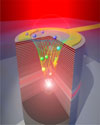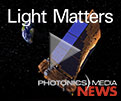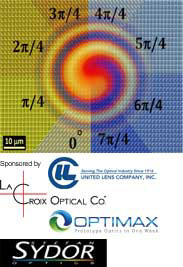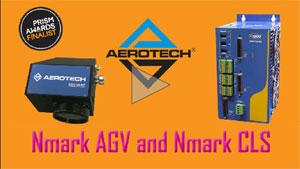 
 |
Polariton Laser Is Electrically Injected
An international team led by Stanford University's Yoshihisa Yamamoto demonstrated a revolutionary electrically driven polariton laser that could significantly improve laser efficiency by requiring 100 times less power than conventional lasers. "We're hoping we can replace conventional semiconductor lasers with these polariton lasers in the future," said physicist Na Young Kim, a member of the Stanford team. "There are a lot of hurdles in the way, but we aim to bring novel devices built on sound physical understanding for cost-effectiveness and efficient power consumption. We've solidified our physical understanding, and now it's time we think about how to put these lasers into practice. This is an exciting era to imagine how this new physics can lead to novel engineering." |
|
|
|

Nanoantennas Improve Infrared Sensing
Patterning nanoantennas with “slots” that correspond to wavelengths in the mid-IR yielded a new way to tune IR light into mechanical action, paving the way for more sensitive IR cameras and more compact chemical-analysis techniques, says a team at the University of Pennsylvania. |
|
|
|

Laser World of Photonics Numbers High, Mark Industry Upswing
Record numbers of exhibitors and foreign visitors, and insight into revolutionary technologies at Laser World of Photonics and the World of Photonics Congress, held May 13-16 in Munich, marked an upswing in the photonics industry, show organizers Messe Munchen said. |
|
|
|




Wheels Come Off Planet-hunting Telescope
The wheels have literally come off the Kepler space telescope, NASA’s primary instrument for detecting planets beyond our solar system. Last week's malfunction leaves just two of the four stability-controlling wheels operational, jeopardizing the sun-orbiting spacecraft's continued mission. |
|
|
|

Alloys So Bright They Could Have Medical Apps
Nanoscale alloys with properties drastically different from those of their predecessors — including near-infrared light emission — could have potential medical applications, say chemists at the University of Pittsburgh. |
|
|
|

Electronic Components Speed Spectroscopy
By combining an electro-optic modulator with an optical resonator, scientists at the National Institute of Standards and Technology changed a scanning laser’s frequency evenly and made it more than 1000 times faster, permitting full-spectrum scans within a few milliseconds. |
|
|
|

 |
sponsored by
 |
On this edition of the industry's premier weekly newscast: The wheels come off the Kepler space telescope, nanoantennas improve infrared sensing, and Managing Editor Laura Marshall shares her final impressions of Laser World of Photonics 2013. Co-hosted by Photonics Media Senior Editor Melinda Rose. |
|
|


Composite Created with Specific Optical Properties
By adding semiconducting nanoparticles to polymers, scientists at the UPV/EHU-University of the Basque Country created composites with specific optical and electrical properties that vary according to size. Such particles could find use in optoelectronics, biomedicine and solar panel applications. |
|
|
|



WEBINAR

 |
Join Us for a Free Webinar
2013 Webinar Series - Expert Briefings
Developments in Optics and Optical Components
Wednesday, May 29, 2013 – 1 p.m. EST/10 a.m. PST
 3-D Gradient-Index Polymer Optics 3-D Gradient-Index Polymer Optics
Dr. Robert R. McLeod, Associate Professor and Graduate Director
Electrical, Computer and Energy Engineering Department
University of Colorado at Boulder
 Photonic Metasurfaces Photonic Metasurfaces
Patrice Genevet, Research Associate
Professor Federico Capasso's Group
Harvard University
|
|
|

CLEO 2013 - June 9 - 14, 2013 · San Jose, CA
Visit Photonics Media at Booth 2027 |

 |
CLEO, the Conference on Lasers and Electro-Optics, is the premier international forum for scientific and technical optics, uniting the fields of lasers and electro-optics by bringing together all aspects of laser technology, from basic research to industry applications. CLEO 2013 will feature its technical program under three core conferences; CLEO: QELS-Fundamental Science, CLEO: Science & Innovations, and CLEO: Applications & Technology.
The CLEO: Market Focus program focuses on the latest trends in the photonic marketplace, providing a forum to discuss new products and emerging technologies and markets while also providing network opportunities. Presentations for this year include Industrial Laser Outlook and Opportunities, Photonics Entrepreneurs, Medical and Aesthetic Lasers – The Future of Light-tissue Interactions, and Optics & Innovation for Energy & the Environment. Free exhibit floor programs include the Market Focus program, Technology Transfer Showcase, OSA’s Executive Speaker Series and the CLEO: Expo Technology Playground, where top industry players will demonstrate their latest products and services in an exclusive on-floor event that allows attendees to participate in live, interactive presentations.
MORE INFO >> |
|
|
 |


Follow Photonics Media on Facebook and Twitter
|
   |
|

FEATURED VIDEO

Aerotech - Nmark AGV Galvanometers
Nmark AGV galvanometers use innovative optical feedback technology to increase resolution to greater than 24 bits, compared with the 16 or 20 bits achieved by other high-end scanners for laser micromachining applications. The result is a significant improvement in accuracy: A 100-mm focal length lens has 2-D positioning accuracies of 10 µm or better. Company: Aerotech 101 Zeta Drive Pittsburgh, PA 15238 sales@aerotech.com phone: 412-963-7470 Product: Nmark AGV and Nmark CLS Website: www.aerotech.com
|
|
|

sponsor
 |

sponsor
 |


sponsor
.png) |

sponsor
 |



|